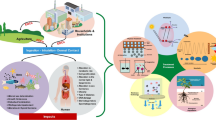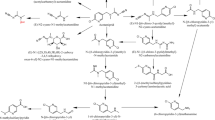Abstract
Atrazine (ATR), one of the most widely used herbicides in the world, affects not only target organisms but also the biota in general. Here, the teratogenic and neurotoxic effects of ATR on Rhinella arenarum (South American toad) embryos, and larvae were evaluated by means of standardized bioassays during acute and chronic exposures. The herbicide had a significant incidence of malformations, with a Teratogenic Index (TI) of 3.28. The main effects were delayed development, reduced body size, microcephaly, axial flexures, wavy tail and edema. In addition, delayed development, reduced development of forelimbs, and edema were recorded at metamorphosis stages. Scanning electron microscopy allowed observing different degrees of cellular dissociation and persistent cilliar cells in specific regions like the adhesive structure and tail fin. Results obtained by ATR 24 h pulse exposures at six developmental stages pointed out blastula as the most susceptible developmental stage both for immediate and delayed adverse effects. A noteworthy recovery capacity from acute toxic effects was recorded from the neural plate stage onwards. Regarding neurotoxic effects, abnormal, and erratic swimming and spasmodic contractions were recorded. Both the teratogenic and neurotoxic effects reported in this study demonstrate the importance of evaluating sublethal effects in non-target organisms as they could imply reduced fitness of individuals and eventually a population decline. The Hazard Quotients (HQ) for ATR ranged from 0.14 to 10.80, and the fact that some of these values are above USEPA’s level of concern indicate that ATR is likely a risk to R. arenarum.



Similar content being viewed by others
References
Syngenta Crop Protection Inc. (2011) Gesaprim 90 WDG® product manual. http://www.syngenta.com.ar/(S(cuciqh55tkot4eby2fwumdqn))/Cultivos/viewimage.aspx?id=746. Accessed 17 November 2011
Alford RA, Richards SJ (1999) Global amphibian declines: a problem in applied ecology. Ann Rev Ecol Syst 30:133–165
Allran JW, Karasov WH (2001) Effects of atrazine on embryos, larvae, and adults of anuran amphibians. Environ Toxicol Chem 20(4):769–775
Aronzon CM, Sandoval MT, Herkovits J, Pérez-Coll CS (2011) Stage-dependent toxicity of 2,4-dichlorophenoxyacetic on the embryonic development of a South American toad, Rhinella arenarum. Environ Toxicol 26(4):373–381
ASTM (1993) Standard guide for conducting the Frog Embryo Teratogenesis Assay-Xenopus (FETAX). American Society for Testing and Materials. Standards on Aquatic Toxicology and Hazard Evaluation, Philadelphia, PA
Bantle JA, Dumont JN, Finch RA, Linder G, Fort DJ (1998) Atlas of abnormalities. A guide for the performance of FETAX, 2nd ed.Oklahoma State University, Stillwater
Beebee TJC, Griffiths RA (2005) The amphibian decline crisis: a watershed for conservation biology? Biol Conserv 125:271–285
Blaustein AR, Wake DB (1990) Declining amphibian populations: a global phenomenon? Trends Ecol Evol 5:203–204
Boutin C, Freemark KE, Keddy CJ (1993) Proposed Guidelines for Registration of Chemical Pesticides: nontarget plant Testing and Evaluation. Technical Report Series 145. Canadian Wildlife Service (Headquarters), Environment Canada, Ottawa, 91p
Boutin C, Freemark KE, Keddy CJ (1995) Overview and rationale for developing regulatory guidelines for nontarget plant testing with chemical pesticides. Environ Toxicol Chem 14(9):1465–1475
Brodeur JC, Svartz G, Perez-Coll CS, Marino DJG, Herkovits J (2009) Comparative susceptibility to atrazine of three developmental stages of Rhinella arenarum and influence on metamorphosis: non-monotonous acceleration of the time to climax and delayed tail resorption. Aquat Toxicol 91(2):161–170
Brodie ED, Formanowicz DR (1983) Prey size preference of predators: differential vulnerability of larval anurans. Hepetologica 39(1):67–75
Bushway RJ, Perkins LB, Fukal L, Harrison RO, Ferguson BS (1991) Comparison of enzyme-linked immunosorbent assay and high-performance liquid chromatography for the analysis of atrazine in water from Czechoslovakia. Arch Environ Contam Toxicol 21(3):365–370
Carr JA, Gentles A, Smith EE, Goleman WL, Urquidi LJ, Thuett K, Kendall RJ, Giesy JP, Gross TS, Solomon KR, Van Der Kraak G (2003) Response of larval Xenopus laevis to atrazine: assessment of growth, metamorphosis, and gonadal and laryngeal morphology. Environ Toxicol Chem 22(2):396–405
CASAFE (2011) Cámara Argentina de Sanidad Agropecuaria y Fertilizantes. http://200.69.30.152/~admin33/estad/Mercado2010.htm Accessed 17 November 2011
Cooke AS (1971) Selective predation by newts on frog tadpoles treated with DDT. Nature 229:275–276
Cooper RL, Stoker TE, Tyrey L, Goldman JM, McElroy WK (2000) Atrazine disrupts the hypothalamic control of pituitary-ovarian function. Toxicol Sci 53(2):297–307
Davies PE, Cook LSJ, Barton JL (1994) Triazine herbicide contamination of Tasmanian streams: sources, concentrations and effects on biota. Aust J Mar Freshw Res 45(2):209–226
Del Conte E, Sirlin L (1951) The first stages of Bufo arenarum development. Act Zoo Lilloana 12:495–499
Echeverría DD, Fiorito De López LE (1981) Estadios de la metamorfosis en Bufo arenarum (Anura). Physis Secc. B. Bs. As 40(98):15–23
APHA, editor (1980) American Public Health Association. Standard Methods for the Examination of Water and Wastewater, 15th edn. APHA-AWWA-WPCF, Washington DC, 1000 p
Ezemonye L, Tongo I (2009) Lethal and sublethal effects of atrazine to amphibian larvae. Jordan J Biol Sci 2(1):29–36
Hayes T, Collins A, Lee M, Mendoza M, Noriega N, Stuart AA, Vonk A (2002) Hermaphroditic, demasculinized frogs after exposure to the herbicide atrazine at low ecologically relevant doses. Proc Natl Acad Sci U S A 99(8):5476–5480
Hayes T, Haston K, Tsui M, Hoang A, Haeffele C, Vonk A (2003) Atrazine-induced hermaphroditism at 0.1 ppb in American leopard frogs (Rana pipiens): laboratory and field evidence. Environ Health Perspect 111(4):568–575
Herkovits J, Faber J (1978) Shape: its development and regulation capacity during embryogenesis. Acta Biotheor 27(3–4):185–200
Herkovits J, Pérez-Coll CS (2003) AMPHITOX: A customized set of toxicity tests employing amphibian embryos. Symposium on multiple stressor effects in relation to declining amphibian populations. In: Linder GL, Krest S, Sparling D, Little EE (ed) Multiple Stressor Effects in Relation to Declining Amphibian Populations. ASTM International STP 1443, USA, pp 46–60
Herkovits J, Ponce B, Olabe J (1980) Efecto de la prostaglandina F2 alfa sobre la proliferación celular y el transporte de Na, K, Ca y Mg en células epiteliales embrionarias. Medicina 40:858–859
Herkovits J, Cardellini P, Pavanati C, Pérez-Coll CS (1997) Susceptibility of early life stages of Xenopus laevis to cadmium. Environ Toxicol Chem 16(2):312–316
Herkovits J, Pérez-Coll C, Herkovits FD (2002) Ecotoxicological studies of environmental samples from Buenos Aires area using a standardized amphibian embryo toxicity test (AMPHITOX). Environ Pollut 116(1):177–183
Herzog DC, Funderburk JE (1986) Ecological bases for habitat management and pest cultural control. In: Kogan M (ed) Ecological theory and integrated pest management practice. Wiley, New York, pp 217–250
Houlahan JE, Findlay CS, Schmidt BR, Meyer AH, Kuzmin SL (2000) Quantitative evidence for global amphibian population declines. Nature 404(6779):752–755
Kiesecker JM, Blaustein AR, Belden LK (2001) Complex causes of amphibian population declines. Nature 410(6829):681–684
Langerveld AJ, Celestine R, Zaya R, Mihalko D, Ide CF (2009) Chronic exposure to high levels of atrazine alters expression of genes that regulate immune and growth-related functions in developing Xenopus laevis tadpoles. Environ Res 109(4):379–389
Lenkowski JR, Reed MJ, Deininger L, McLaughlin KA (2008) Perturbation of organogenesis by the herbicide atrazine in the amphibian Xenopus laevis. Environ Health Perspect 116(2):223–230
Little EE, Archeski RD, Flerov BA, Kozlovskaya VI (1990) Behavioral indicators of sublethal toxicity in rainbow trout. Arch Environ Contam Toxicol 19(3):380–385
Mann RM, Hyne RV, Choung CB, Wilson SP (2009) Amphibians and agricultural chemicals: review of the risks in a complex environment. Environ Pollut 157(11):2903–2927
Morgan MK, Scheuerman PR, Bishop CS, Pyles RA (1996) Teratogenic potential of atrazine and 2,4-D using FETAX. J Toxicol Environ Health 48(2):151–168
Nieves-Puigdoller K, Björnsson BT, McCormick SD (2007) Effects of hexazinone and atrazine on the physiology and endocrinology of smolt development in Atlantic salmon. Aquat Toxicol 84(1):27–37
Pérez-Coll CS, Sandoval MT, Herkovits J (2009) Efectos letales y teratogénicos del Funguicygon® en embriones de Bufo arenarum. In SETAC (ed) Química y Toxicología Ambiental en América latina. Desafíos, perspectivas y nuevos enfoques. ISBN: 978-987-25370-0-5, Argentina, pp 86–88
Pintér A, Török G, Börzsönyi M, Surján A, Csík M, Kelecsényi Z, Kocsis Z (1990) Long-term carcinogenicity bioassay of the herbicide atrazine in F344 rats. Neoplasma 37(5):533–544
Pisanó A (1956) Efficienza funzionale e structura dell′ ipofisi di anfibio. Arch Zool Ital 42:221–227
Relyea RA (2009) A cocktail of contaminants: how mixtures of pesticides at low concentrations affect aquatic communities. Oecologia 159(2):363–376
Rohr JR, Elskus AA, Shepherd BS, Crowley PH, McCarthy TM, Niedzwiecki JH, Sager T, Sih A, Palmer BD (2003) Lethal and sublethal effects of atrazine, carbaryl, endosulfan, and octylphenol on the streamside salamander (Ambystoma barbouri). Environ Toxicol Chem 22(10):2385–2392
Sass JB, Colangelo A (2006) European Union bans atrazine, while the United States negotiates continued use. Int J Occup Environ Health 12(3):260–267
Semlitsch RD (1990) Effects of body size, sibship, and tail injury on the susceptibility of tadpoles to dragonfly predation. Can J Zool 68(5):1027–1030
Silvestre F, Trausch G, Spanò L, Devos P (2002) Effects of atrazine on osmoregulation in the Chinese mitten crab, Eriocheir sinensis. Comp Biochem Physiol C: Toxicol Pharmacol 132(3):385–390
Simic B, Kniewald J, Kniewald Z (1994) Effects of atrazine on reproductive performance in the rat. J Appl Toxicol 14(6):401–404
USEPA (1988) EPA Probit analysis program for calculating EC/LC values. Version 1.5. United States Environmental Protection Agency, Cincinnati, OH
USEPA (1998) Guidelines for ecological risk assessment. Ecological Risk Assessment Step 2. United States Environmental Protection Agency, Washington, DC. http://www.epa.gov/R5Super/ecology/html/erasteps/erastep2.html. Accessed 17 November 2011
Van der Hoeven N (1997) How to measure no effect. Part III. Statistical aspects of NOEC, ECx and NEC estimates. Environmetrics 8(3):255–261
Van der Hoeven N, Noppert F, Leopold A (1997) How to measure no effect. Part I. Towards a new measure of chronic toxicity in ecotoxicology, introduction and workshop results. Environmetrics 8(3):241–248
Wetzel LT, Luempert LG III, Breckenridge CB, Tisdel MO, Stevens JT, Thakur AK, Extrom PJ, Eldridge JC (1994) Chronic effects of atrazine on estrus and mammary tumor formation in female Sprague-Dawley and Fischer-344 rats. J Toxicol Environ Health 43(2):169–182
Yoder J, Watson M, Benson WW (1973) Lymphocyte chromosome analysis of agricultural workers during extensive occupational exposure to pesticides. Mutat Res 21(6):335–340
Acknowledgments
JH and CPC are scientists of the National Council of Science and Technology of Argentina (CONICET); GVS has a fellowship from CONICET. We thank Dr. Damian Marino for his help with the determinations of ATR in water and Dr. Julie Brodeur for technical assistance. We thank Fabian Tricarico for skilful technical assistance for SEM studies and the reviewers of the MS for very meaningful suggestions. This work was supported by PIP CONICET 5324, UNSAM SA project 08-02 and the ECOTOX grant from Fundación PROSAMA.
Author information
Authors and Affiliations
Corresponding author
Rights and permissions
About this article
Cite this article
Svartz, G.V., Herkovits, J. & Pérez-Coll, C.S. Sublethal effects of atrazine on embryo-larval development of Rhinella arenarum (Anura: Bufonidae). Ecotoxicology 21, 1251–1259 (2012). https://doi.org/10.1007/s10646-012-0880-9
Accepted:
Published:
Issue Date:
DOI: https://doi.org/10.1007/s10646-012-0880-9




